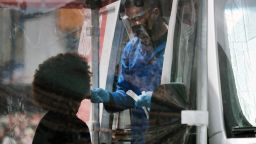Editor’s Note: Kent Sepkowitz is a physician and infectious disease expert at Memorial Sloan Kettering Cancer Center in New York. The views expressed in this commentary are his own. View more opinion on CNN.
Here we are two-and-a -half years and many variants into the coronavirus pandemic, and the virus continues to surprise.
Take the recent news about the latest Omicron subvariant, labeled BA.5. According to Eric Topol, a cardiologist and professor of molecular medicine at Scripps Research, BA.5 is the most transmissible version the virus. It combines more efficient transmission and better immune evasion from previous infection and is driving a slow but steady rise of hospitalizations related to Covid-19 across the United States.

The million-dollar question now is not whether BA.5 (and its companion, the slightly less transmissible BA.4) will cause a major uptick in infection across the country – it has, and it will – but rather whether anyone, including those who have been vaccinated or have developed infection or both, is safe from its voracious reach.
The facts so far are anything but assuring. To explain the situation, I will use the “just the numbers, ma’am” subvariant classification that is dizzying for some and soporific for others. But here it goes: Omicron BA.4 and BA.5 are indeed slippery and seem to have evaded our current messenger RNA vaccine-induced immunity as well as the immunity provoked by infection due to all known variants (initial, Alpha, Delta) except perhaps Omicron and its spawn: BA.1, which caused the US December-January outbreak, and BA.2, including BA.2.12.1, which was responsible for the spring outbreak, particularly in the Northeast.
In a preliminary study from Qatar, which has not yet been peer-reviewed, previous Omicron infection was more than 75% effective in preventing new BA.4/BA.5 disease. A similarity between the BA.2.12.1 and the newer BA.4/BA.5 subvariant in spike protein structure as well as the “fit” of receptor sites may explain some of this apparent protection, according to a study in the journal Nature.
Given that the old vaccines and pre-Omicron variant infections are not protective against new infection (though still remarkably effective at preventing serious disease and death), what about the new vaccines that finally appear ready for prime time?
Much attention has been given to a vaccine made by the American biotech company Novavax, which just received emergency use authorization from the US Food and Drug Administration. On Tuesday, the vaccine advisers of the US Centers for Disease Control and Prevention voted 12-0 to recommend the use of the Novavax Covid-19 vaccine as a two-dose primary series in adults. Dr. Rochelle Walensky, director of the CDC, said that she has endorsed the recommendation. Novavax has said that its vaccine shows “broad” immune response to circulating variants, including Omicron subvariants BA.4 and BA. 5.
Hopefully, Novavax’s assertion will translate into a meaningful difference in protection against new infection. The data available so far is from laboratory studies, not a clinical trial of patients at risk for the disease.
Ditto for the new generation of mRNA vaccines that contain new elements to induce antibodies against some Omicron strains – the variant specific or “adapted” mRNA shots. (The current vaccines target the original SARS-CoV-2 variant that dominated in 2020.) It is uncertain whether these updated vaccines will be effective against BA.4 and BA.5 (or whatever comes next), though the preliminary results from Qatar provide some reason for optimism. After all, if previous omicron infection may elicit effective antibody against the newest variants, so too might a vaccine that induces similar antibodies to this ever-shifting variant.
The dream, of course, remains a vaccine that can produce a response that could handle any and all variants. It is not clear that such a vaccine is a realistic hope, at least in the short term. Finding a genetic sequence of the coronavirus that both is preserved across all variants and provokes potent antibodies is easy to think about but extremely difficult to develop.
The example of the still-unsuccessful, 35-year pursuit of a vaccine to prevent HIV infection is a reminder that scientific progress is always completely unpredictable.
Despite all these worries, I am not overly frightened about what’s ahead. Yes, the BA.4/BA.5 wave will cause illness, upset plans and add to the daily annoyance of everyone. However, we are not in a free fall like we were in 2020.
In addition to the current lifesaving vaccines and the effective treatments for established infection, we have epidemiologic facts. With the original Omicron subvariants, BA.1 and BA.2, the intensity of the infection in the US came a month or more later than in South Africa and several weeks later than in Western Europe.
The latest dominant subvariant hasn’t caused a substantial increase in hospitalizations or deaths in either South Africa or Western Europe. As with the previous Omicron subvariants, it seems likely that the US will follow those regions once again, with or without the new souped-up vaccines. If true, Americans have not yet seen the worst of BA.4 and BA.5. Hospitalizations and deaths in the US are rising and these subvariants will continue to increase their reach over the next few weeks.
It may be until mid-August before we experience the now-familiar sense of things quieting down. By then, the latest member of the Omicron clan, BA.2.75, dubbed unofficially the “Centaurus,” may be upon us. So, keep plenty of masks, plan your gatherings carefully and get a vaccine booster. Then prepare for a not-so-lively autumn.

